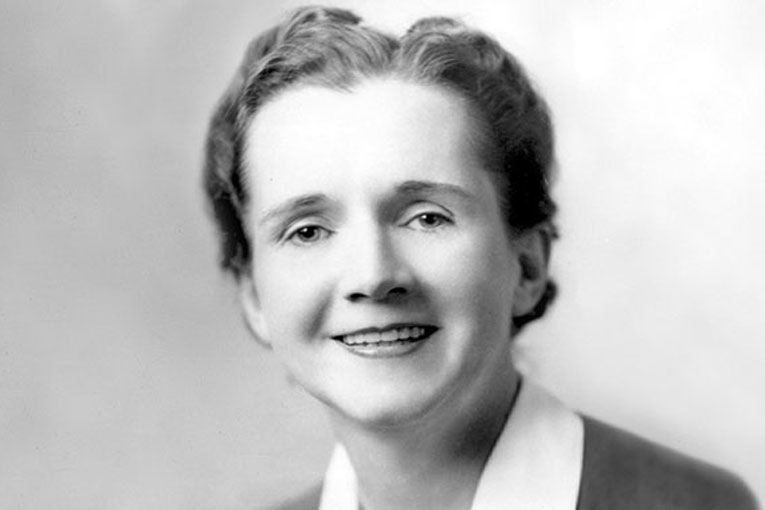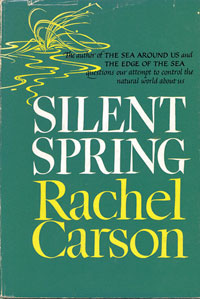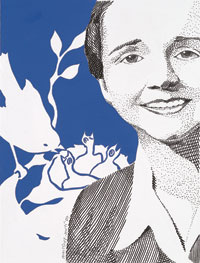
 |
||
|
A letter written by her friend Olga O. Huckins, where she explained that the birds at her sanctuary in Massachusetts were dying due to fumigations carried out at the moment, is what inspired Rachel Carson to write Silent Spring, her most renowned book, published back in September 1962. Carson, who was working at the U.S. Fish and Wildlife Service as a marine biologist, had already shown her concern about the pollution caused by some particular pesticides. But it was not until she denounced the DDT effects, a very popular chemical compound back then, that her criticism achieved the status it deserved. At least in her own country. Beyond the USA borders, the impact of her studies was limited. Last week, the IEC held a roundtable discussion in Barcelona to analyse how Silent Spring has influenced the Spanish society 50 years after its publication, which was broadcasted live at the Lopez Piñero Institute for the History of Science and Medicine in Valencia. With the publication of Silent Spring she became an icon for the young ecology movement, but she also faced the agrochemical industry, which was not willing to give up the profits DDT supposed for them. Even though Carson’s book was welcomed by the general public –it was among the best sellers for 31 months—, in part due to her plain style, its author was severely criticised. Critics pointed to the alleged lack of scientific rigour (Carson’s work was not linked to a university) and a rejection of progress on Carson’s side. In addition, they described it as emotive for the sole fact that it had been written by a woman (her detractors described her as a hysterical spinster who loved more animals than humans). Carson was threatened to be accused of defamation by some of the companies involved. All in all, president Kennedy commanded an investigation on DDT effects which resulted in the confirmation of Carson’s theses in 1963. In fact, this chemical compound was banned in most developed countries. However, many people think that Rachel Carson’s outcry was not taken seriously enough. Silenced Spring—Carson’s low impact beyond the US borders Silent Spring‘s case is a good example to talk about science credibility; its relationship with society or how it deals with gender issues. This is why the roundtable discussion held by the IEC dealt with the impact of the book in Spain from the point of view of ecology, toxicology, science communication or history. The event was divided in four different parts showing four different points of view. In the first part, Joandomènec Ros, full professor of Ecology at the UAB and translator of Silent Spring ainto Spanish, gave a talk focused on taking to pieces the arguments used against Carson, especially those referred to her pessimism and lack of rigour, and reminded the audience that the author not only cared for animals, but was also concerned about the negative effects of DDT on the people’s economy and health. Ros cited the article The lies of Rachel Carson, written by the entomologist J.Gordon Edwards— one of the few critic texts that do not come from the agrochemical industry— which pointed out one some methodological mistakes Carson might have made. According to Ros, the small impact of Carson’s work in Spain is in part due to the poor quality of the Spanish translations of the time. In addition, Ros pointed out the importance Silent Spring had for ecology because it introduced new concepts like ecological agriculture or external contamination. |
« With the publication of Silent Spring Carson became an icon for the young ecology movement, but she also faced the agrochemical industry»
«According to Joandomènec Ros, the small impact of Carson’s work in Spain is in part due to the poor quality of the Spanish translations of the time»
«Joaquim Elcacho concluded that the imact of Silent Spring had been very small in Spain and that the DDT ban had more to do with economic inerests than with an ecological concern» |
|
|
The science journalist Joaquim Elcacho was next and made a presentation on the reception of Carson’s work. Elcacho remarked that Silent Spring had not been mentioned in any of the works published in Spain he had studied on nature and the environment (Natura: ús i abús, 1976; La contaminación, 1973; El combat ecologista a Catalunya, 1979), nor in the 1973 and 1977 editions of the Great Catalan Encyclopaedia. Regarding the mass media, Elcacho pointed out that some very important publications during Franco’s regime, like Triunfo or Blanco y negro, made virtually no mention of Carson’s book. The newspapers La Vanguardia, mentioned Silent Spring in 1973 for the first time. In 1994, Mercè Piqueras wrote an article on the book. Surprisingly, the medium that published more about it was a conservative newspaper, ABC, which published the results of Kennedy’s Commission of Inquiry and followed the case in the USA thanks to their correspondent there, Josep Maria Massip. Elcacho concluded that the impact of Silent Spring had been very small in Spain and that the DDT ban had more to do with economic interests than with ecological concern. The problem of internal contamination Are we more protected against contamination than we were in 1962? This is the question doctor Miquel Porta, expert in toxicology, tried to answer in a talk that showed his concern for the current levels of internal contamination in populations from post-industrial countries. According to Porta, the small impact of Silent Spring in Spain can be noticed in the lack of public or private policies to fight against internal contamination. The researcher gave some data on the levels of toxicity in humans in Catalonia and supported the fight for people’s health. In addition, he reminded that DDT is undeniably toxic, and can lead to illnesses like childhood asthma, obesity or diabetes. Porta denounced the tolerance society practices in front of the abuses and deceptions of the food industry —main source for internal contamination— and finished his talk suggesting there is a link between the toxic effects on humans of compounds like DDT and some diseases whose causes are still unknown, like Alzheimer’s. Controversy arrived with Antonio Buj’s talk, PhD. in human geography by the UAB, who tried to refute two «half-truths» that could be found in Carson’s book, using locust pests as an example. First of all, Buj questioned the idea of Nature’s moral authority, arguing that humans could not remain impassive in front of pests. Secondly, the expert rejected Carson’s proposal of reducing the use of chemical products since, form his point of view, although toxic, compounds like DDT have helped to eradicate diseases like malaria, still existing in the poorest countries. Debate livened up during question time when there were discrepancies around this topic between Buj and Elcacho. In any case, the roundtable discussion showed two things —that Silent Spring had not the impact it deserved and that we still have time to make it heard today, since many of the problems described by Rachel Carson in 1962 are still affecting us today. Felip Pineda. Journalist, Valencia. |
«Miquel Porta denounced the tolerance society practices in front of the abuses and deceptions of the food industry and suggested that there is a link between the toxic effects on humans of compounds like DDT and some diseases whose causes are still unknown »
«Antonio Buj questioned the idea of Nature’s moral authority, arguing that humans could not remain impassive in front of pests» |
|







